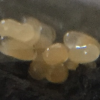I went on my first anting trip yesterday to the desert, Barstow, CA, and scored several queens, thanks Drew for pointing out a spot! I was not prepared for so many so some of them don't have a test tube setup and are living in a small container with a small piece of wet cotton at the moment. Thanks to the guys I talked to yesterday for tips. I only know some of these species because I looked up pictures of what Drew caught. There was one type that didn't look like any of what he caught.
Species Collected:
Pheidole xerophila
Dorymyrmex insanus
Myrmecocystus navajo
Pogonomyrmex rugosus
Unknown species <- click for picture
So at this point I was brainstorming dirt setups since I've read Pogonomyrmex do better in them. I wondered what would be bad about simply filling a glass jar with moist soil and placing a P. rugosus in them. Someone pointed out the dirt would collapse if they dug out a section of it so there has to be a center piece to help hold up the soil. So two containers with one inside the other is the basic setup.
How about moisture?
I thought about using grout but that takes several days to cure. Hydrostone I'd have to order and it'd take days as well. Plaster of paris is known to melt from moisture. I then thought about just watering the surface of the dirt by either dripping water down the sides slowly or spraying the surface with a spray bottle. This raised a a few questions.
Would the dirt collapse because of watering it?
Is it better to have the moisture coming from the bottom of the soil like in Drew's dirt shack or above like rain?
How moist is good enough and to what depth of soil?
Another observation I noticed was that the soil was moist to only about 6 inches deep max. I know this because I dug out several founding chambers and I hit dry soil after 4-6 inches consistently. Both the M. navajo were dug out at 6 inches. By the time I left the surface soil had dried considerably from the heat. Since rain comes very rarely in the desert, I assume the soil will dry out completely at some point in time.
So is moisture actually a concern in our dirt formicariums for Pogonomyrmex?
Would Pogonomyrmex actually live just fine with a completely dry substrate?
Maybe it is as simple as moisture makes the soil easier to dig. Maybe rain triggers nuptial flights because the ground is finally malleable. I'm not sure that's why I'd like to have a discussion so people can chime in what they know from experience or reading.
Off topic: but how long does 6 inches of rain take to dry out in the desert?
















